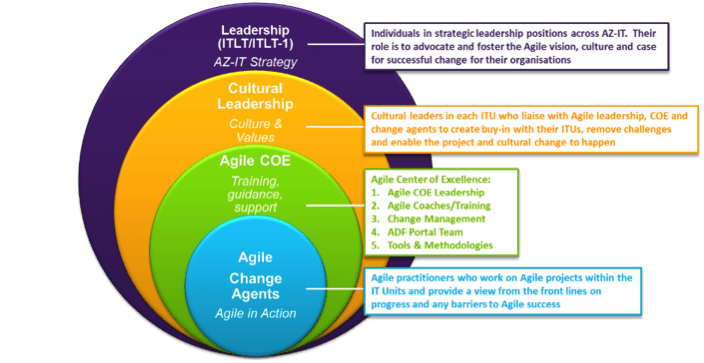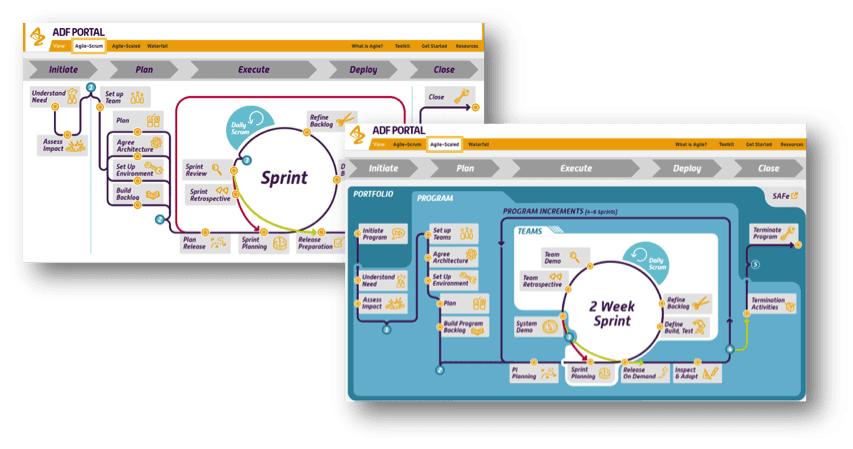
“We’re delivering faster with greater quality and less manpower—resulting in substantial financial benefits from the teams that have adopted Agile to date. We expect to double our adoption of Agile this year.”
—Patty Sheehan, AZ Agile Cultural Change Lead and Coach
Challenge:
Scale Agile practices across a large global change portfolio
Industry:
Pharmaceutical
Results:
- Substantial financial benefits delivered in the first year
- Significantly faster time-to-value delivery
- Reduced team sizes
- Improved quality of outputs over previous solutions
Best Practices:
- Address culture change – AZ focused on the culture shift required to support Agile by creating Culture Leaders.
- Align governance and procurement – AZ aligned funding and governance approval with Agile ways of working, enabling teams to make progress quickly and benefit from Agile delivery.
- Consider face-to-face ARTs – AZ required face-to-face planning at the launch of a new Agile Release Train (ART).
- Stay organized – AZ used task tracking and collaboration tools extensively.
Introduction
AstraZeneca (AZ) is a global, science-led biopharmaceutical business employing 61,500 employees worldwide. Millions of patients around the globe use its innovative medicines. AZ activities span the entire life cycle of a medicine, from research and development to manufacturing and supply to the global sales and marketing of primary care and speciality care medicines that transform lives.

AZ teams are pushing the boundaries of science to make a difference through medicine for patients, their families, our stakeholders, and society in general. AZ believes that scientific research and applying leading technology are key to achieving cutting-edge innovation and at the heart of what we do.
In AZ, IT is helping to push the boundaries of science to deliver life-changing medicines by continuously improving the IT environment and working with business teams to innovate for competitive advantage.
Enterprise-wide Alignment with Agile
AZ has made use of Agile practices for a number of years at a small scale, but up to 2014 had continued to deliver the majority of its programs using traditional SAFe approaches. A decision was taken to adopt Agile methods more broadly across its IT change portfolio in order to bring about a step change in delivery performance. PA Consulting was selected by AZ to support this agile transformation effort, providing organizational change management expertise, Agile transformation strategy, training and coaching. AstraZeneca and PA Consulting selected the Scaled Agile Framework® (SAFe®) in late 2014 as the framework to be applied to support the adoption of Agile.
“We needed the ability to scale Agile quickly because we run large, complex programs at AstraZeneca,” says Patty Sheehan, AZ Agile Cultural Change Lead and Coach. “SAFe is a flexible yet robust framework that has already been proven successful. It has been the right fit for us.”
The SAFe Agile adoption approach focused on organization and culture change, supporting Agile teams directly and ensuring that processes such as procurement and regulatory approval were aligned with Agile. The Agile adoption has so far been extremely successful with teams reporting significantly faster time to value delivery (40-60%), reduced team sizes (cost reduction of 25-40%) and improved quality. Financially, we rigorously monetized a large proportion of benefits from just a small subset of teams.
The AZ team, supported by PA Consulting, rolled out SAFe in the first year to tackle the larger scale programs in its portfolio, focusing on three key areas:
- Organization and culture change:
The transition to Agile ways of working can be a substantial break with traditional corporate culture. AZ defined five key organizational values: customer focus, technical leadership, operational excellence, collaboration and simplicity. By becoming Agile, AZ people would not only know these values but practice them in a methodical way.AZ tied this message into an Agile vision statement and marketing, making the change feel more personal and organic. The culture change approach included creating an extensive network of Agile Culture Leaders across the organization, focused on executive-level buy-in. The company also dedicated additional time at the end of each SAFe training course to the discussion and diagnosis of immediate actions to change culture.

- Alignment of governance, procurement and regulatory processes with SAFe:
AZ replaced its traditional project governance framework with a new Adaptive Delivery Framework that was easy to use, lightweight, and crucially, supported both Scrum and Scaled Agile approaches out of the box. With this change, funding and governance approval were aligned with Agile ways of working, enabling teams to make progress quickly and benefit from Agile delivery. As a regulated pharmaceutical organization, AZ also has many regulatory obligations on its systems and processes. Defining an approach with the internal Quality Management group was a key success criteria, allowing the AZ Agile teams to deliver validated software solutions that supported regulatory requirements.

- Outsourced and offshore teams:
AZ teams are typically made up of a number of different third-party suppliers working in collaboration with AZ from a variety of sites around the world. We overcame the challenges inherent in this arrangement, building on key elements of SAFe to support this way of working. The PI Planning event was crucial to the alignment and co-ordination of large, off-shore teams. These events were carried out using a mixture of on-site and video conferencing facilities, with a requirement for face-to-face planning at the launch of a new ART. Similarly, iteration alignment and system demos helped the teams to maintain visible synchronization throughout increments. The Legal and Procurement teams at AZ are revising the contractual arrangements and procurement processes to align with SAFe. Task tracking and collaboration tools were used extensively. Following the success of the Agile adoption in the first year, AstraZeneca is now creating a number of internal ARTs to deliver change, again utilizing a multi-site model.
Value Delivered in Year One
AstraZeneca is 18 months into a multi-year transition to Agile ways of working, but with the adoption of the Scaled Agile Framework and the support of PA Consulting, a substantial transformation has already occurred. Twenty large teams have adopted Agile, and over 1000 staff have been trained and supported through a robust coaching regime. More importantly, Agile maturity has increased rapidly over the year with strong adoption in each area of the business. The teams adopting SAFe have observed significantly increased time to value delivery with improved quality of the outputs over previous solutions. This has been achieved more efficiently with reduced team sizes
“We’re delivering faster with greater quality and less manpower—resulting in substantial financial benefits from the teams that have adopted Agile to date,” Sheehan says. “We expect to double our adoption of Agile this year.”
Share:
Back to: All Case Studies
Suggested Case Study: Royal Philips